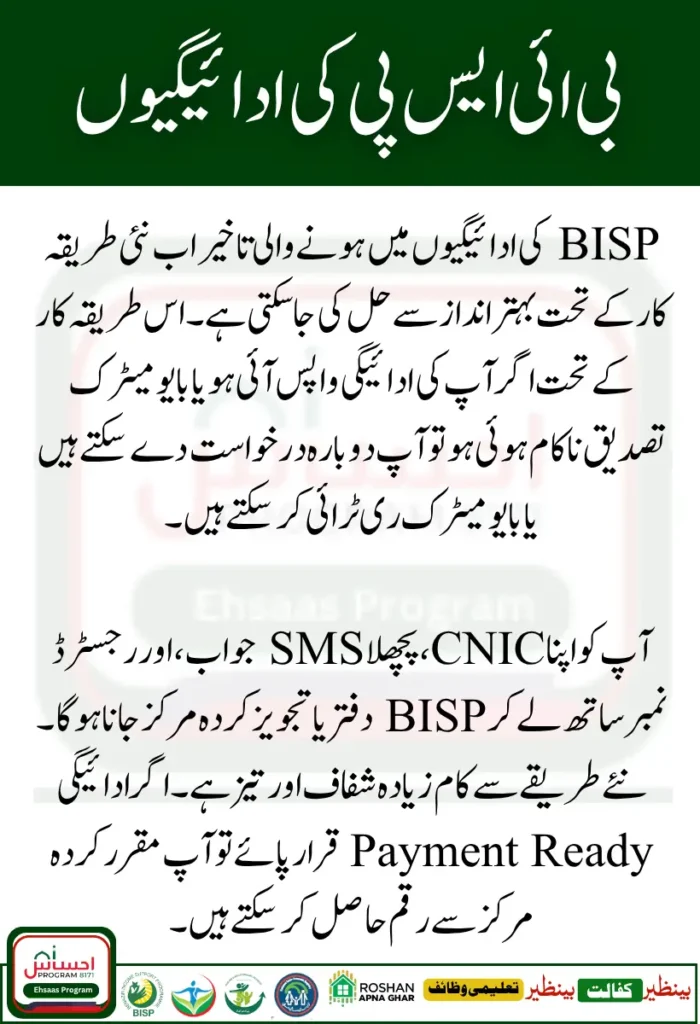Many beneficiaries under the BISP Payment Delay Issues wait anxiously when their quarterly stipend is delayed. Payment delays cause real hardship; families count on that money for food, medicine, school fees, and other essentials. Fortunately, recent updates in BISP’s system and alternative methods now help resolve many of these delays faster. In this article, you’ll learn why delays happen, what the new method is, how to apply it in your case, and how to avoid delays in future.
You Can Also Read : How to Withdraw BISP Payment from HBL ATM

Why BISP Payments Are Delayed Often
Delays in BISP payments are rarely random. Understanding the root causes helps you take corrective action. Some frequent causes are:
- Biometric verification failure
Sometimes the fingerprint or thumb impression you provide at the payment center does not match NADRA’s record. This mismatch causes the system to block your payment until re-verification is done. - Expired or unverified CNIC
If your identity card is expired or your details in NADRA don’t match the BISP database, your disbursement may be withheld. - Becoming a tax filer
In certain cases, when someone in the household becomes a filer (registered for taxes), the system flags the family as potentially ineligible. That can halt payments. - Technical glitches or system errors
BISP sometimes faces server or portal malfunctions, which delay mass disbursement. In July 2025, such a technical problem disrupted many payments until the error was fixed. - Unupdated family or address records
If your address, family composition, or children’s B-forms are not updated, your file may be flagged and your payment delayed. - Returned payments (undelivered or blocked funds)
Sometimes the payment reaches the bank or system but is returned to source due to failed withdrawal, account block, or other mismatch. BISP later reissues those payments, but that causes delay.
Because of these varied reasons, a one-size fits all solution did not always work. That is why BISP has introduced a new method (or updated procedures) to reduce delays, reprocess stuck payments, and help beneficiaries fix common problems more easily.
You Can Also Read ; Check Your BISP PMT Score by CNIC Easy Method
What Is the New Method to Fix Delays
The new method refers to updated procedures BISP has started using in 2025 to address payment delays more proactively. Instead of passive waiting, beneficiaries can now trigger reprocessing, re-verification, or reissue requests through improved channels. Key elements of this method include:
- Auto reissue for returned payments
If your payment was returned due to bank/withdrawal failures, BISP now schedules an automatic reissue of that amount in the next cycle. No fresh registration is required in many cases. - Biometric retry facility
Beneficiaries whose biometric attempt failed can now revisit a biometric retry desk at certain payment centers to reattempt thumb/fingerprint scanning without reapplication. - Dynamic re-verification requests
You can request re-verification of your CNIC, address, or family data through official channels (BISP offices or digital requests) so that your record is unlocked for payment. - Official complaints / grievance channel activation
BISP’s complaint or grievance systems (online or helpline) now faster escalate cases of delayed payments so that stuck payments are reviewed manually. - Technical fix cycles by BISP teams
When delays are due to system errors or glitches, BISP technical teams now deploy correction windows during which stuck payments are pushed into the system in bulk after manual cleanup.
Because of this new multi-pronged approach, many delays that once lasted weeks are now resolved in days provided beneficiaries use the right steps.
You Can Also Read : 8171 Ehsaas Program Phase 3 Payments
Step-by-Step: Use the New Method to Solve Delay
Here is how you can apply the new method if your BISP payment is late:
- Check your payment status
Use your CNIC via SMS (send to 8171) or via the official 8171 web portal. Confirm whether your payment shows Eligible, Ready, Returned, or Not found. - Identify the reason for delay
Based on the message you get or by visiting the BISP office, find if the hold is due to biometric failure, CNIC mismatch, returned payment, etc. - Visit biometric retry desk (if offered)
If your issue is a fingerprint mismatch, go to a payment center or biometric retry point and ask staff to allow you to re-scan your thumb. Carry your CNIC and prior SMS. - File a reissue request (returned payment)
If your payment was returned, submit a request (or register a complaint) through BISP’s grievance portal or local office to get your amount reissued in the next disbursement cycle. - Submit data correction / re-verification request
If your CNIC, address, or family data is out of date, visit a local BISP or NADRA office to update your record. Ask them to push your case for re-verification in BISP’s system. - Contact BISP via official helpline / grievance system
Provide your CNIC, case details, and request escalation. Ensure your complaint is logged formally. - Keep checking status until resolved
After your request is processed, re-check via SMS or portal. Once Payment Ready appears, collect your stipend from the designated payment center.
Following these steps is much more effective under the new BISP approach than waiting passively.
Documents, Info & Conditions You Must Check
Before applying any delay-fix method, ensure you have:
- Valid original CNIC
- Mobile number registered under your CNIC
- Previous SMS replies or portal printouts if you received them
- Knowledge of your biometric attempt location
- Any records of returned payment (if applicable)
Also watch for:
- Your status must not show disqualified if so, first resolve disqualification reasons
- Avoid using third party agents only official staff and channels can fix delays
- Do not give your PIN or sensitive data to anyone
Why This New Method Works Better
This revamped process has key advantages over old passive waiting:
- It forces you to push your own case rather than passively wait.
- It addresses common failure points (biometric, returned payment) directly.
- It reduces backlogs, manual escalations and reissue cycles force cleanup.
- It improves transparency and you can see status updates faster through the portal/complaint system.
- It helps identify systemic errors BISP can batch-fix similar issues across many cases.
In early 2025, beneficiaries in multiple districts reported payment delays due to technical faults; after BISP invoked the reissue and correction cycles, those payments began to flow again.
Many payment delays were previously blamed on logjams or missing eligibility; now they are being solved via active reprocessing.
You Can Also Read : BISP Double Payment 27000 Announced
Common Pitfalls to Avoid
- Do not re-register entirely using the new reissue / retry approach
- Do not pay any agent to speed up your payment this is a scam
- Do not give fingerprint or PIN to unauthorized persons
- Do not repeatedly try biometric scanning in wrong machines ask staff to allow safe retry
- Do not ignore system messages from 8171 they often tell you exactly what error is blocking your payment
FAQs
How many days of delay is considered normal?
Typically a delay of 7 to 14 days is manageable due to system processing. Delays beyond that are serious and you should invoke the new method.
If my payment was returned, will I lose it permanently?
No. Under the new method, BISP schedules those returned payments for automatic reissue in many cases. You just need to file the request or register the complaint.
Can biometric retry be done anywhere?
Not always. Only designated payment centers or retry desks support biometric retry. Ask staff first to direct you.
What if no official correction happens?
Escalate your case through BISP helpline and grievance channels. Visit the regional BISP office for manual intervention.
Disclaimer
⚠️ Disclaimer: This article is for informational purposes only. We are not affiliated with any government agency. For official updates, visit the official BISP website.
Note: This content is based on publicly available information. We are not affiliated with BISP or any government body. Read full disclaimer here.
